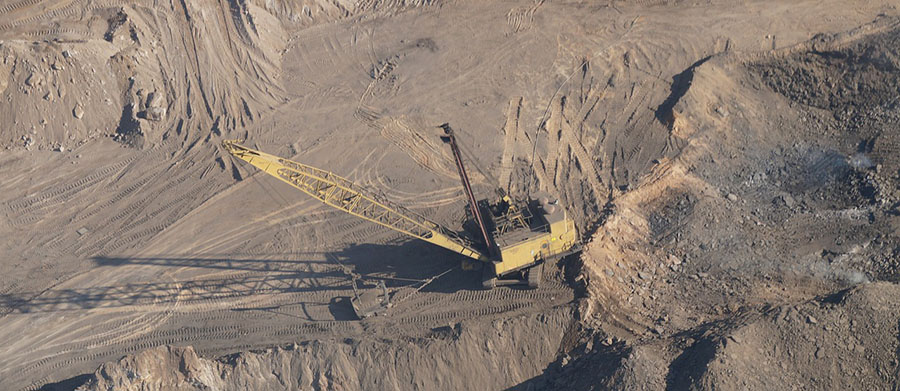Coal has been used for nearly as long as mankind has thrived. From the times of the cavemen to present day, coal is used for everything from cooking to heating to running steam-powered trains to generating electricity.
Today, coal is burned as fuel or gasified to create a synthesis gas (syngas) that can then be used as a feedstock for the production of chemicals, fertilizer and electric power. Coal is also used for producing heat through combustion.
The U.S., Russia, Australia, China, India and South Africa have the largest coal reserves in the world. Coal is produced in 25 states in the U.S., spread across three coal-producing regions. The majority of the current production originates in just five states: Wyoming, West Virginia, Kentucky, Pennsylvania and Montana.
The importance of coal as a source of generating power has increased over time with the rise in industrialization. In due course, alternatives to coal for generating power have now curbed the dominance of coal to some extent.
Opportunities
Coal Dominates U.S. Power Generation: Coal as a major source of fuel for power generation dominates the utility industry. Coal is used to generate about half of the electricity consumed in the U.S. and is also the largest domestically produced source of energy. Electricity generation absorbs about 93% of total U.S. coal consumption. The reason is simple: Coal is by far the least expensive and most abundant fossil fuel in the country.
Coal will continue to dominate as the major source of electricity production. Taking into consideration the long-term prospect of coal, one of its key producers Arch Coal Inc. (ACI/Analyst Report) expanded its reserves in the Powder River Basin (PRB) through a successful bidding of a coal lease. The coal produced from South Hilight coal reserves are of high quality. This high quality, ultra-low-sulfur-dioxide-content coal is in huge global demand due to stringent government regulations on emission (pollution) standards.
In contrast, petroleum and nuclear power as sources of power generation have been losing market share displaced by the strong growth of renewable sources of generation and natural gas-fired generation. Petroleum is losing out to coal because it is becoming increasingly expensive. After the Japan earthquake/tsunami incident in 2011, nuclear power's contribution to the total energy generation has declined from the prior year.
Not Just Electric Generation: Electricity generation is just one use of coal in the U.S. Manufacturing plants and industries use coal to make chemicals, cement, paper, ceramics and metal products, to name a few. Methanol and ethylene, which can be made from coal gas, are used to make products such as plastics, medicines, fertilizers and tar.
Certain industries consume large amounts of coal. For example, concrete and paper companies burn coal, and the steel industry uses coke and coal by-products to make steel for bridges, buildings and automobiles.
Coal as an Input for Steel Industry: Due to its heat-producing feature, hard coal (metallurgical or coking coal) forms a key ingredient in the production of steel. Nearly 70% of global steel production depends on coal. The steel companies foresee a return of prospects in 2012 due to improving demand from the end markets.
Coal Trade
According to an Energy Information Administration (EIA) report, U.S. coal exports in 2011 were 107 million short tons (Mt), which reflected growth of 31% year over year. Flooding in Australian mines during 2011 disrupted coal exports, which benefited U.S. producers. The upsurge in coal exports during 2011 mainly emanated from demand from Asian countries. As per the EIA report, with Australian mines back in operation, U.S. coal exports are expected to decline to 100 Mt in 2012.
The projected average delivered coal price to the electric power sector, which was $2.40 per million British thermal units (MMBtu) in 2011, is expected to fall to $2.38/MMBtu in 2012 and $2.30/MMBtu in 2013. The downside is attributed to lower demand for coal in generating electricity.
Demand Upsurge in Asian Countries: The increase in coal demand in Asian economies like China and India has been a key price driver since the end of the recession in 2009. We expect this trend to continue in future mainly due to the growing energy needs in India, China and South Korea.
Of the Asian countries, economic growth in China and India will be the fastest. These two countries do produce coal, but its domestic coal production has yet to match the growing demand, resulting in the continuous need of importing coal. These countries rely heavily on coal for electricity generation.
A major portion of the new electricity generation units, which are expected to come up in these two countries, will utilize coal as a source of fuel. As per The Economic Times, it is projected that coal imports will touch 1 billion tons in China in 2030 from the present level of 175 Mt in 2011. Indian imports for coal are expected to reach 400 Mt in 2030, up from 80 Mt in 2011.
Given the growing demand from the fast-growing Asian economies, companies find it attractive to export coal to the emerging regions. Some of the names making the most from overseas coal exports are Peabody Energy Corporation (BTU/Analyst Report) and CONSOL Energy Inc. (CNX/Analyst Report). To cater to the increasing demand of coal in Asian countries, Peabody has acquired Macarthur Coal in Australia and expanded its footprint in high-demand regions.
Elsewhere, certain coal master limited partnerships (MLPs), including Penn Virginia Resource Partners L.P. (PVR/Analyst Report), Natural Resource Partners L.P. (NRP/Analyst Report) and Alliance Resources Partners L.P. (ARLP/Snapshot Report), are also good investment bets for people seeking exposure in the coal sector.
Weaknesses
According to the EIA's report, U.S. coal production in 2012 will experience a dip from the last five-year average. The projected decline is attributed to lower demand due to adverse weather conditions, large stock of coal and increasing competition from natural gas as an alternate fuel.
In the ensuing year, the demand for coal to produce power is likely to fall 10% from the previous year due to increasing use of natural gas to generate power. EIA forecasts coal use in the U.S. power sector to fall below 900 Mt in 2012 and 2013.
Coal is plentiful and fairly cheap relative to the cost of other sources of electricity, but its use produces emissions that adversely affect the environment. Coal emits sulfur dioxide, nitrogen oxide and mercury, which have been linked to acid rain, smog and health issues. Coal also emits carbon dioxide, a greenhouse gas that contributes to climate change.
Without proper care, coal mining can have a negative impact on ecosystems and water, and alter landscapes and scenic views. With governments becoming more and more stringent on environmental issues, the electricity generators are implementing new measures to bring down emission levels of greenhouse gases.
As per an EIA report, the combined impact from the usage of natural gas and renewable sources to generate power will gradually reduce the share of coal to produce electricity to 39% in 2035 from the high of 49% in 2007.
Environmental Legislations: Coal has been losing its importance as a fuel source over the last few years, particularly in the U.S., vis-ŕ-vis other sources that have a lesser impact on the environment. Concerns on the emission of greenhouse gases and global climate change have resulted in the formulation of new legislations and policies which emphasize on the use of environment friendly fuel sources, particularly in the power sector.
This has considerably slowed the expansion of coal-fired capacity in the power sector, with utility companies now building new natural gas-fired plants and resorting to alternative sources of energy generation like wind, solar and hydro power. To meet the environmental regulations, American Electric Power (AEP) has decided to retire 4,600 megawatts (MW) of coal-fired generation from its portfolio.
Natural Gas Substituting Coal: A major substitute for coal in energy generation is natural gas. Coal is being dumped in favor of natural gas, which due to extensive exploration and production, is seeing significantly lower prices than in the past.
Natural gas is usually an attractive choice for new generating plants because of its relative fuel efficiency, low emissions, quick construction timelines and low capital costs. There is an abundance of natural gas in the U.S. markets, resulting in lower prices. This trend is encouraging power generators to not only convert their existing plants to gas-fired ones but to build new nat-gas units.
Electric generation through gas-fired plants is likely to become more competitive over the coming years given its abundant domestic availability and the threat of regulation hanging over the coal mining industry. As per EIA's reports, 96.65 gigawatts (GW) of new electric generation will be added in the U.S. within 2009–2015, out of which 20% will be natural gas-fired plants.
Large electricity generators in the U.S., like Exelon Corporation (EXC), FirstEnergy Corp. (FE/Analyst Report) and others are turning to natural gas for additional electrical capacity.
Competition from Alternative Energy Sources: Apart from natural gas, the coal industry has been losing a major share of its electric generation demand to renewable sources of energy like wind, solar and hydro power.
Production of power from renewable sources has also been supported by the various U.S. states. At present there is no national consensus regarding the percentage of energy to be generated from renewable sources by the power generators.
Undoubtedly, state legislators are giving more emphasis to produce power from renewables. At present, 30 U.S. states and District of Columbia have enforceable renewable portfolio standards or other renewable generation policies. These policies were designed to spread awareness and encourage the power generators to produce more from renewable sources.
The share in energy generation of renewable fuels (including conventional hydro) is projected to grow from 10% in 2010 to 16% in 2035, as per the EIA's long-term outlook.
In Conclusion
Though there is ample pressure on coal from legislations and increasing competition from natural gas and renewable energy sources, we believe the global power industry will continue to depend on coal for a large part of its generation. Coal as a fuel source will continue to power the growth in emerging nations like China and India, both for utility companies and steel makers as it is cheaper compared to other energy sources.
On the flip side, the debt crisis in Europe is still lingering, despite relief packages that have already been announced to revive the economy. The uncertain economic climate continues to impact the industry and curb its growth prospects. The lackluster demand for steel, which is widely used in different industries, could be an indicator of where we are heading.
ArcelorMittal (MT/Analyst Report), a major producer in the global steel industry, has as yet idled 5 of its 25 blast furnaces in Europe due to tepid demand. Likewise, demand for coal is expected to decline in Europe as the steel industry consuming a large volume of high quality coal continues to struggle.
The EIA estimates, even if no new reserve is added, the present U.S. coal reserve will exhaust in 168 years, taking into consideration the incremental production rate. This is promising because, in addition to the many existing ways to use coal, the future holds new methods and potential for growth. Products from coal may soon be part of communications and transportation systems, computer networks and even space expeditions.
In addition to these new and increased uses of coal, new technologies will continue to enhance the ability to identify the shape and composition of untapped coal reserves. Emerging know-how is also likely to look for a solution to the adverse effects of coal on the environment mitigating greenhouse effects and other environmental concerns.
For example, the dry sorbent injection pollution control technology can play an important part in coal usage in the power plants. This technology will aid the power plant operators using coal to lower SO2 emissions and enable them to comply with the Environmental Protection Agency's Mercury and Air Toxics Standards (MATS).
These new technologies focused on achieving near-zero emissions open up avenues for potential long-term industry growth. Clean-coal technology development in the U.S. also has funding earmarked under the American Recovery and Reinvestment Act of 2009. This is an encouraging sign for coal producers.
Even if alternate sources for generating fuels are available, coal's advantage lies in its price, which is far lower than the other sources of fuel. We believe reinvigorating demand from the growing economies and steady demand from U.S. will drive the coal industry in the future.
Zacks Equity Research
Coal Industry Stock Review
Source: Zacks Equity Research (4/23/12)
"High-quality, ultra-low-sulfur-dioxide coal is in huge global demand due to stringent government regulations on emissions standards."

























































